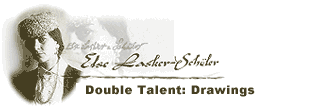|

Lasker-Schüler's
drawings are enduring testimony to her double talent as a poet and artist
and of her conviction that word and image are mutually reinforcing.
She produced watercolors, pastels and collages throughout her life,
and she illustrated several of her books. Beginning in the 1920s, when
her son fell ill with tuberculosis — he died
in 1927 — her artwork provided most of her
income.
Nowhere
is this interconnection of word and image more evident than in Lasker-Schüler's
letters, where hearts and stars are inserted in the midst of words and
between lines and little drawings of an oasis or the profiles of exotic
faces adorn the page. The book Theben (Thebes), consisting of
10 poems and 10 lithographs, with 50 of the 250 copies hand-colored
by the artist, is part of her artistic legacy. Beginning in 1916, exhibitions
of her graphic works were organized by art galleries in Berlin and by
private collectors such as Karl Ernst Osthaus in Hagen. In 1920, twenty-three
of her drawings were given by collector friends to the Berlin National
Gallery.
In
her stories and poems, Lasker-Schüler created an Orientalist fantasy
world . . . a self-created fantasy world of beauty, passion, and cruelty.
The story "I Am Dancing in the Mosque" from the collection
The Nights of Tino of Baghdad, 1907, is an Orientalist Art Nouveau
dream, its language an attempt to imitate dance rhythms. Since the poet's
native German cannot itself convey this poetic Orient, Lasker-Schüler
resorts to Arabic language particles that are repeated rhythmically.
Lasker-Schüler's
favorite biblical figure was Joseph, with whom she identified as an
interpreter of dreams, that is, a poet, misunderstood by his own people
for whom he cared and whom he rescued. After assuming the persona of
the Oriental princess Tino, she created for herself the role of Jussuf,
Prince of Thebes, around 1910. He personified the ideal in which art
and power were finally united. Jussuf is a unique persona, neither Jewish
nor Muslim, male nor female, and eternally
 |
 From:
Bauschinger, Sigrid. "The Berlin Moderns: Else Lasker-Schüler
and Café Culture" in Berlin Metropolis: Jews and the
New Culture 1890-1918. Copyright © 1999 by The Regents
of the University of California; Copyright © 1999 The Jewish
Museum, New York Under the auspices of The Jewish Theological Seminary
of America. (Berkeley: University of California Press, 1999). pp.
75, 77. Permission of University of California Press. From:
Bauschinger, Sigrid. "The Berlin Moderns: Else Lasker-Schüler
and Café Culture" in Berlin Metropolis: Jews and the
New Culture 1890-1918. Copyright © 1999 by The Regents
of the University of California; Copyright © 1999 The Jewish
Museum, New York Under the auspices of The Jewish Theological Seminary
of America. (Berkeley: University of California Press, 1999). pp.
75, 77. Permission of University of California Press. |
|

